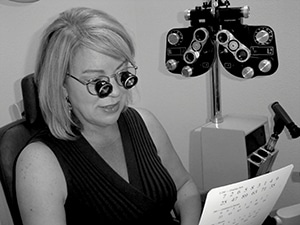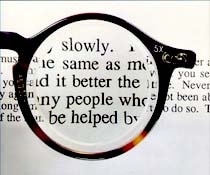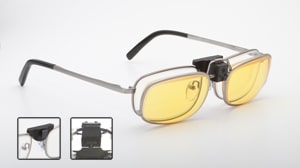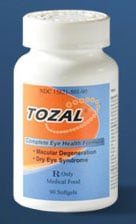910-208-9012
Low Vision Evaluation
The Low Vision Centers of North Carolina provides the fitting of eyeglasses and low vision devices, medical advisory services, and optometry services.
The Low Vision evaluation consists of three steps:
- Find out the amount of vision the patient has.
- Find out the amount of vision needed to do the task desired.
- Figure out the best magnification device that allows the person to do the task.
We find out the amount of vision the patient has by performing a Low Vision evaluation. It is not anything like a regular eye exam:
- We use special charts and techniques to “draw out” any residual vision that may be “hiding” in the periphery.
- We recheck the regular eyeglass prescription to improve it if possible.
- We see how magnification affects the level of vision.
We find out the amount of vision needed to do the task desired with very specific questions and demonstrations.
- We ask the patient to bring samples of print they want to see (newspaper, Sunday school lesson, Bible, and mail).
- We ask the patient to bring samples of activities they do (sewing, woodworking, painting and card playing, etc.).
We figure out the best magnification device that allows the person to do the task by having many unique demonstrators in the office. We do not order any low vision device unless we prove that it works in the office first.
The woman shown above is reading with special eye equipment
The patient actually uses various magnification devices to do the actual task in the office. The patient actually chooses the best device for them.
Telescopic Eyeglasses

Bioptic Position
Smaller telescopes mounted high in the glasses allow the person to view through either the telescope or the “carrier”, the regular prescription lens, by simply moving the head slightly up or down. This position is used for tasks like walking, driving, theater, at sporting events, church or travel.
Full Diameter Position
Either small or larger telescopes are placed in the center of the frame for tasks not requiring mobility. They are used for reading, television, card playing, or simply enjoying seeing the faces of those in conversation.
Near Position
Two telescopes can be “converged” for use at near when reading or performing fine detailed tasks. Telescopes vary in power, field, weight, focusable and non-focusable. Telescopic optics is very complex. The knowledge and experience of the doctor in designing and fitting is extremely important in determining what is best for you. Dr. Paul has fit thousands of patients with telescopic spectacles and is extremely experienced in this area of optometry. Cost varies with the prescription needed in the system and the type of telescopes ordered.
Custom Position
Telescopes can be placed in any position and at any angle a task demands. For example, a custom telescope was designed for a student who needed one telescope angled down for reading and writing and the other up for seeing the teacher and the chalkboard. Telescopes vary in power, field, weight, focusable and non-focusable. Telescopic optics is very complex. The knowledge and experience of the doctor in designing and fitting is extremely important in determining what is best for you. Dr. Paul has fit thousands of patients with telescopic spectacles and is extremely experienced in this area of optometry. Cost varies with the prescription needed in the system and the type of telescopes ordered.
 Microscope Eyeglasses
Microscope Eyeglasses
Microscope Eyeglasses are double lens systems that combine the patients eyeglass prescription with the amount of magnification needed. The amount of magnification depends upon the level of remaining vision and the size of the material to be seen. These state of the art optical systems require two lenses piggybacked to reduce the blur and aberrations caused by high powered lenses. Because they require a close working distance, they are typically used with one eye (monocular).
 Prismatic Eyeglasses
Prismatic Eyeglasses
Prismatic eyeglasses can be single or double lens systems and incorporate prism to allow the two eyes to work together. They are useful for patients whose eyes are approximately equal in vision and do not require high magnification.
 Introducing the E-Scoop®
Introducing the E-Scoop®
The E-Scoop® lens was developed to bridge the gap between standard eyeglasses and head borne telescopes. Whether your difficulty is night driving, bright light, sunlight or simply seeing clearly in the distance, the E-Scoop® lens placed over a standard eyeglass prescription will help you see better. The E-Scoop® lens is comprised of five basic optical properties: custom yellow tint, anti-reflective coating, special lens thickness, base curve, and base up prism. When these five optical properties are combined into the E-Scoop lens, the image is enhanced and shifted to a different part of the macula allowing the patient to see better.
 The NEW Standard of Care for Vitamins and AMD
The NEW Standard of Care for Vitamins and AMD
TOZAL® Eye Health Formula is a unique, patented blend of micronutrients and antioxidants developed to help maintain ocular health and treat age related macular degeneration.
Your eyes are constantly subjected to the cell-damaging effects of free radicals and poor nutrition. Whether you are concerned about ultraviolet radiation from the sun or simply the normal visual decline associated with aging, the TOZAL® components have been proven to neutralize free radicals, and may help preserve visual and macular health.


 Microscope Eyeglasses
Microscope Eyeglasses Prismatic Eyeglasses
Prismatic Eyeglasses Introducing the E-Scoop®
Introducing the E-Scoop® The NEW Standard of Care for Vitamins and AMD
The NEW Standard of Care for Vitamins and AMD